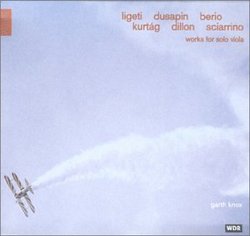| All Artists: Knox, Ligeti, Dusapin, Berio, Kurtag, Dillon Title: Works for Solo Viola Members Wishing: 0 Total Copies: 0 Label: Disques Montaigne Release Date: 10/10/2000 Album Type: Import Genre: Classical Styles: Chamber Music, Forms & Genres, Short Forms, Historical Periods, Classical (c.1770-1830), Instruments, Keyboard Number of Discs: 1 SwapaCD Credits: 1 UPCs: 3298497820820, 713746031626 |
Search - Knox, Ligeti, Dusapin :: Works for Solo Viola
 | Knox, Ligeti, Dusapin Works for Solo Viola Genre: Classical
|
Larger Image |
CD Details |
CD ReviewsViola is given a born again life with Knox as its activist scarecrow | Chicago, Illinois United States | 12/16/2000 (5 out of 5 stars) "Garth Knox supplies fascinating notes here on his work with each solo, each composer.He tried to discover as he states the "sound world" of each composer. Also there is a duality at work here with two Hungarians,(Ligeti and Kurtag), two Italians (Berio and Sciarrino), and two representatives of the younger expressions, Dusapin and Dillon.The viola long has been a neglected instrument, and the 20th century has just about abandoned it altogether, the oldest pieces here the Kurtag from the early Sixties and the Berio Sequenza from 1967 were actually the first pieces to exploit the genre of the solo viola work with9in the avant-garde language. It took Ligeti a full year simply to appreciate each of its strings unique timbre, the low C string first "reminiscent of wood,earth and tannic acid" Then Ligeti heard Tabia Zimmermann in 1990,and found the G string had formidable creative qualities, " grainy,striking but always tender",until the world eclipsed and the entire instrument was entered into Ligeti's imaginative consciousness as having attributes of deep potential. The Sonata here of Ligeti continues on his experimental strain utilizing popular materials, and accessible-like content. Many have labeled this strictly as post-modern, I don't know whose definition would be solicitied; Jameson's or Lyotard,of Habermas, but Ligeti seriousuy imagines he is simply extending the language of modernity. This is a long arduous solo over 19 minutes, and takes on the ponderous shape of a Baroque suite transgressing through "swing" style in some, to as fast as possible in other movements, also microtonal inflections are made part of the more lyrical lamentable movements. Gyorgy Kurtag was the most impeccable to work,according to Knox, with demanding requirements, every tone,nuance inflection, and silence impart a knowable meaning. Jelek or "Signs" have a miniature premise, a wonderful creative approach. These pieces have a grainy, dirty ambience to them despite their miniature elegantlength. Extended techniques are also in ample supply here with mists of harmonics, tremoli, and scouring all the registers with nasal thin harmonics as part of the lyrical line. Salvatore Sciarrino has found a place for himself, at the end of the fruitful lands, the end of modernity, it was a matter of fashioning an aesthetic agenda, one to develop, and Sciarrino here placed the necessity of the solo voice of extended virtuosic techniques as his "garden" of materials to exploit. When you hear his "Tre notturni brillianti" it must have been quite unbelievable music for the Seventies. Large doses of extremely presto, quicksilver moments,improvisatory, scour the entire instrument, nicely shaped inflections and gestures. I found this extended combustable language grows thin after long moments of listening, you simply want to move on to the next timbre. The is a creative/aesthtic ellipsis here which I beleive Sciarrino had simply abandoned for more dramatic creative situations. James Dillon's "siorram" is from 1992 and dedicated to Garth Knox, the title is Gaelic for "in an enchanted sleep" and the barely perceptible dynamic,the bent tone is a focus,a modest solo,filled with some mystery. The Berio is a blistering solo of continuous motion, and Berio always finds a pattern and a means in his materials that makes it work, Here the agenda is quite straghtforward. Dusapin is more a dramatic solo with nice gestures, it is an early work for him long before he contemplated his current neo-romantic phase. It has classical shape in three movements."
|

 Track Listings (20) - Disc #1
Track Listings (20) - Disc #1